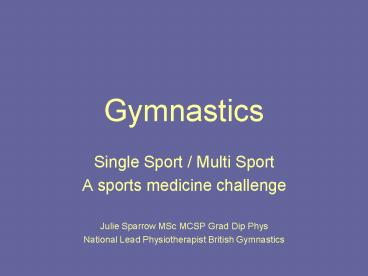Gymnastics - PowerPoint PPT Presentation
1 / 29
Title:
Gymnastics
Description:
Gymnastics Single Sport / Multi Sport A sports medicine challenge Julie Sparrow MSc MCSP Grad Dip Phys National Lead Physiotherapist British Gymnastics – PowerPoint PPT presentation
Number of Views:2909
Avg rating:3.0/5.0
Title: Gymnastics
1
Gymnastics
- Single Sport / Multi Sport
- A sports medicine challenge
- Julie Sparrow MSc MCSP Grad Dip Phys
- National Lead Physiotherapist British Gymnastics
2
Artistic Gymnastics
- Men
- Floor
- Pommel
- Rings
- Vault
- Parallel bars
- High bar
- Women
- Vault
- Bars
- Beam
- Floor
3
Core components of all gymnastics skill
- Body positions (in all swing and flight elements)
- Open trunk extension
- Closed trunk flexed dish
- Straight
- Hand stand
- Splits side and box
- Bridge
4
Core components continued
- Support - weight taken by hands or feet
- Swing in which the body travels about a fixed
point - Flight with or without directional change
- Balance
- Rebound
5
Rhythmic gymnastics
- Women only
- Use of small apparatus
- Ball
- Ribbon
- Hoop
- Club
- rope
6
Rhythmic Gymnastics
Flexibility Co-ordination Flight Expression
Elegance Dance
7
Hypermobile Tall and slender Balance on
large base of support
8
Making of a gymnast
- Many will start working on gymnastic related
skill elements by the age of 6 - Naturally self selecting based on skill
confidence and courage - Women peak in the mid to late teens
- Men peak in late teens into early 20s
9
The influence of the growing skeleton
- Growth plate injury
- Compression load bearing in support
- Shear rotational stress
- Traction take off landing and swing.
- Trauma
- Ligamentous
- Bony
10
(No Transcript)
11
Epiphyseal (Salter Harris) fracture
12
Avulsion fracture
13
Buckle (Torus) fracture of the proximal radius
14
Plastic Bending fracture
15
The At Risk Spine
16
(No Transcript)
17
Source of back pain
- Bone stress reaction pars stress - end
plate - Spondylolysthesis
- Ligamentous stress
- Annular stress and loss of disc integrity
- Zygapophyseal stress
- Muscle strain
18
Shoulder and upper quadrant
19
Shoulder and upper quadrant
- Impingement
- Labral
- Rotator cuff
- Tendon rupture
- Rotator cuff
- Biceps
- Pectoralis major
20
Elbow wrist and hand
21
Clinical problems at the wrist
- Physeal stress
- Physeal arrest
- Scaphoid impaction
- Scaphoid stress
- Ulnar impaction
- Avascular necrosis of the capitate
- Carpal chondromalacia
- Dorsal impingement/capsulitis
- Tears of the triangular fibro cartilage
- Carpal instability
- Distal radio ulnar instability
22
Anterior
Posterior
23
Forearm
- Pommel arm
- Compartment like syndrome of the forearm
24
Injury potential in the lower limb
- Take off
- Landing
- Rebound
25
Soft tissue
- Achilles tendon
- Anterior knee pain syndromes
- Muscle trauma
26
Bony Injury
- Traction apophysisitis
- Bone bruising
- Osteochondritis dissecans
- Chondral defect
27
Bone bruise of the femoral condyle
28
Chondral defect of the talus
29
Summary
- Gymnastics is a potentially a high risk sport
- The growing body is at risk of injury if
progression is not judiciously managed - Gymnastics can provide positive benefits for
motor skills and bone health































